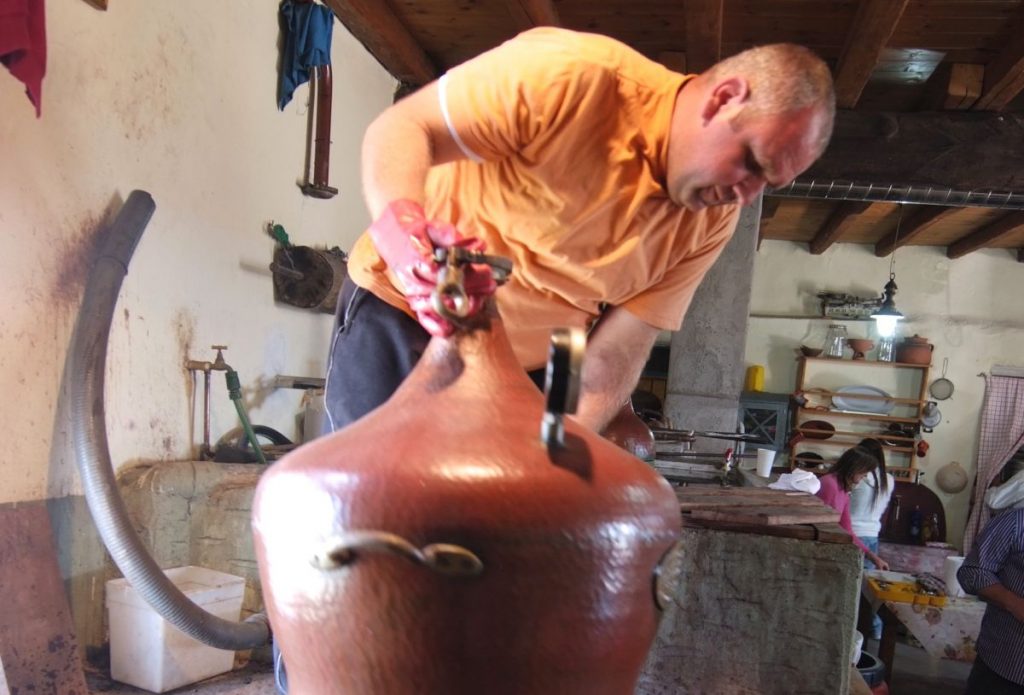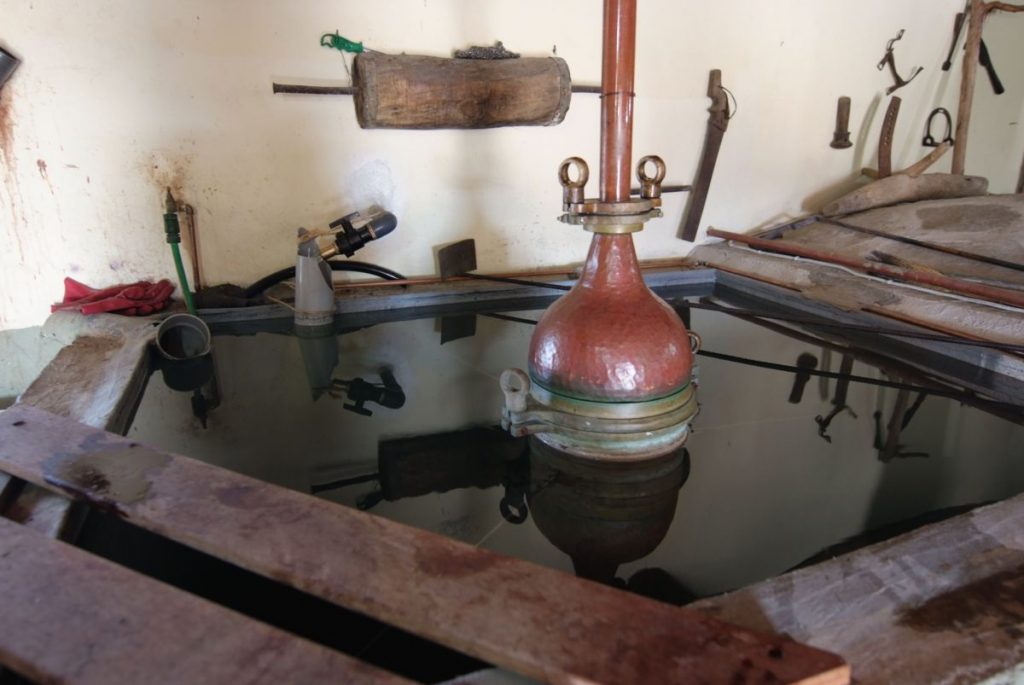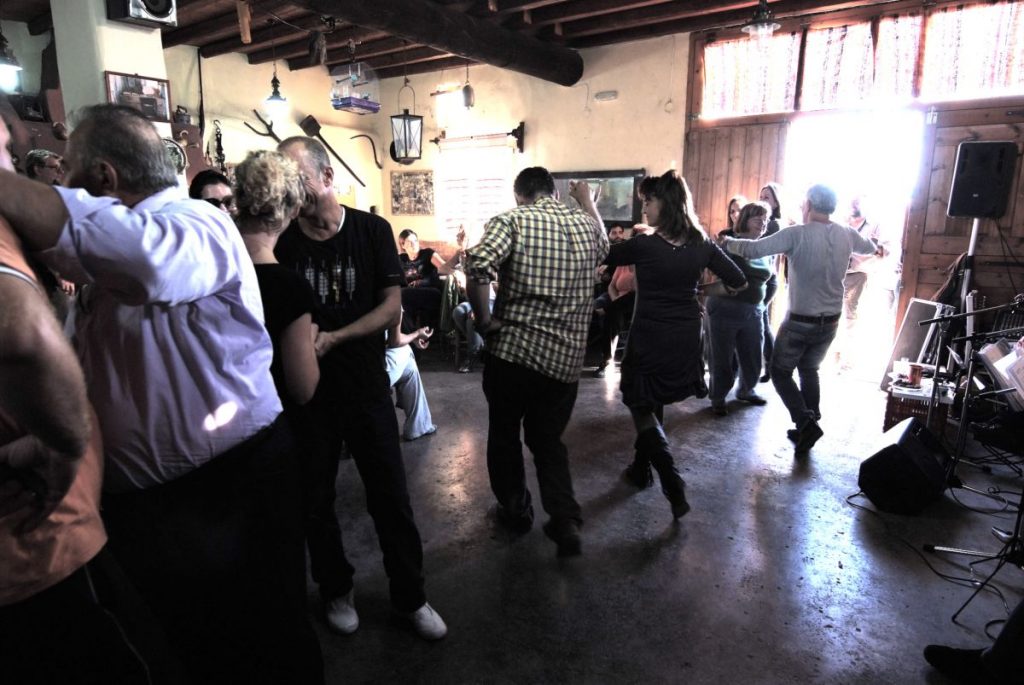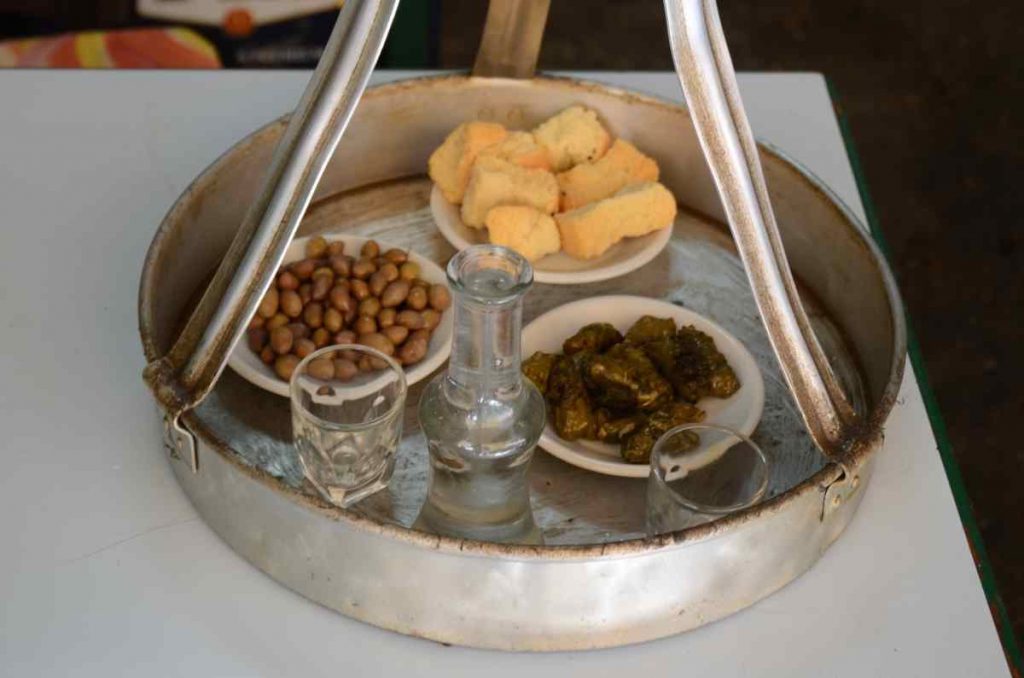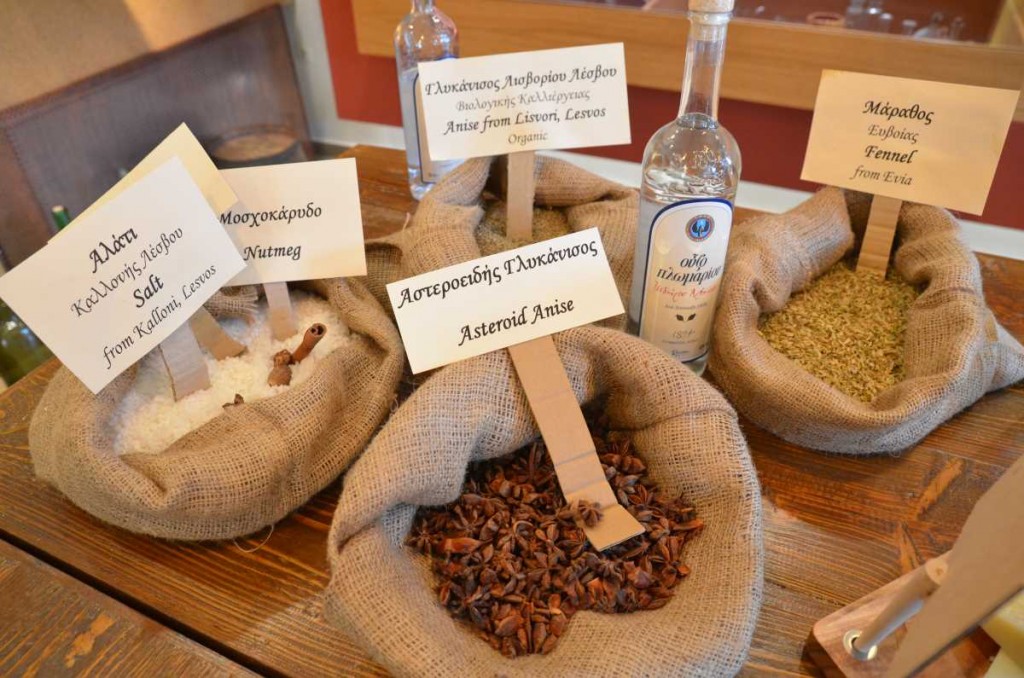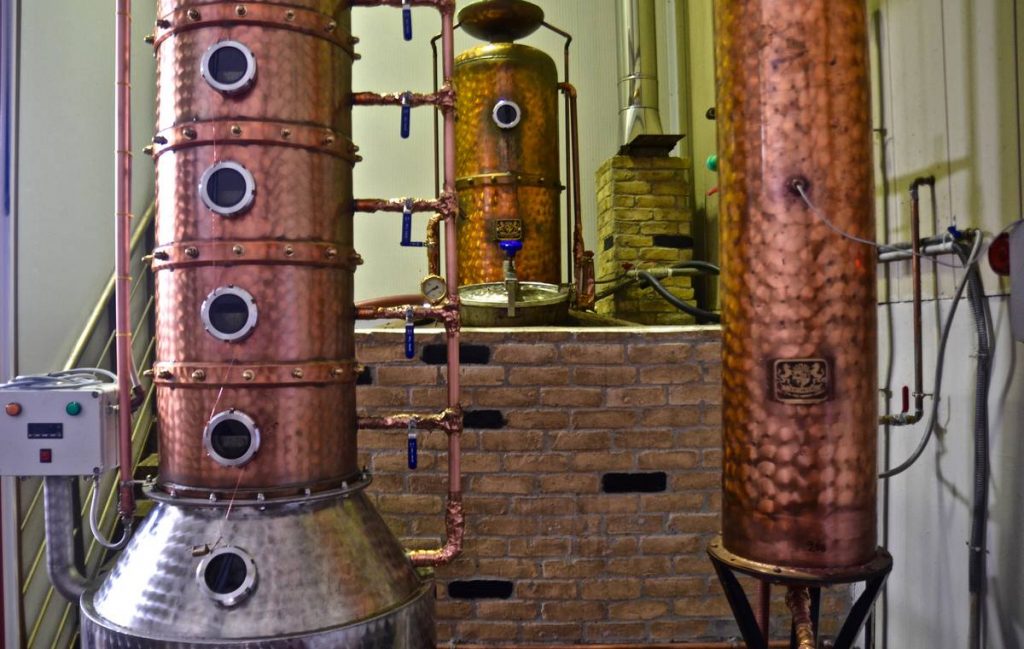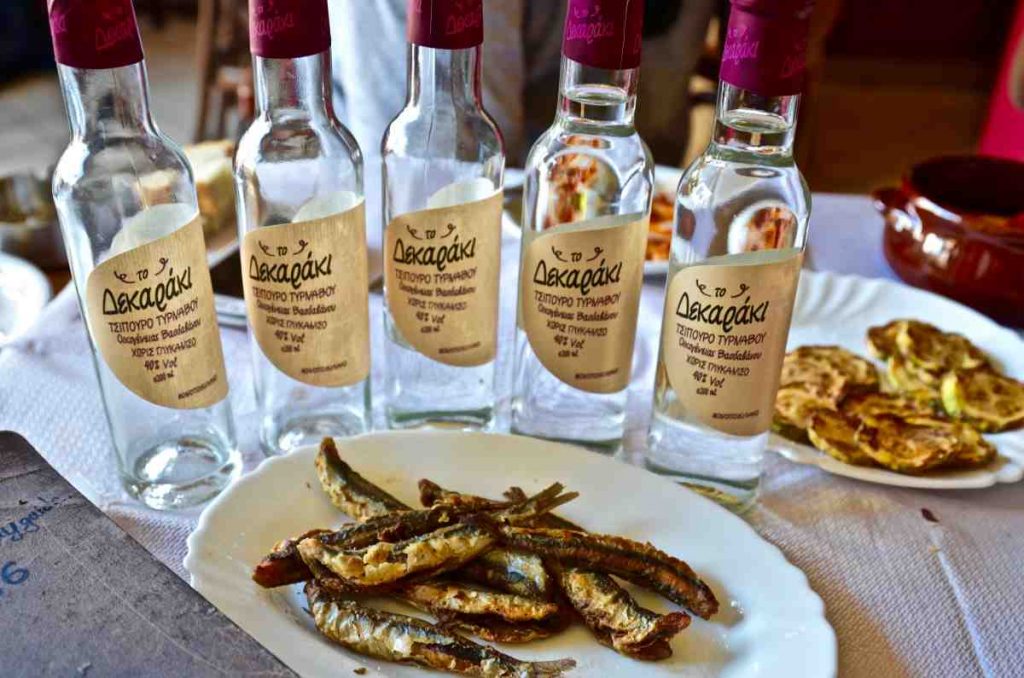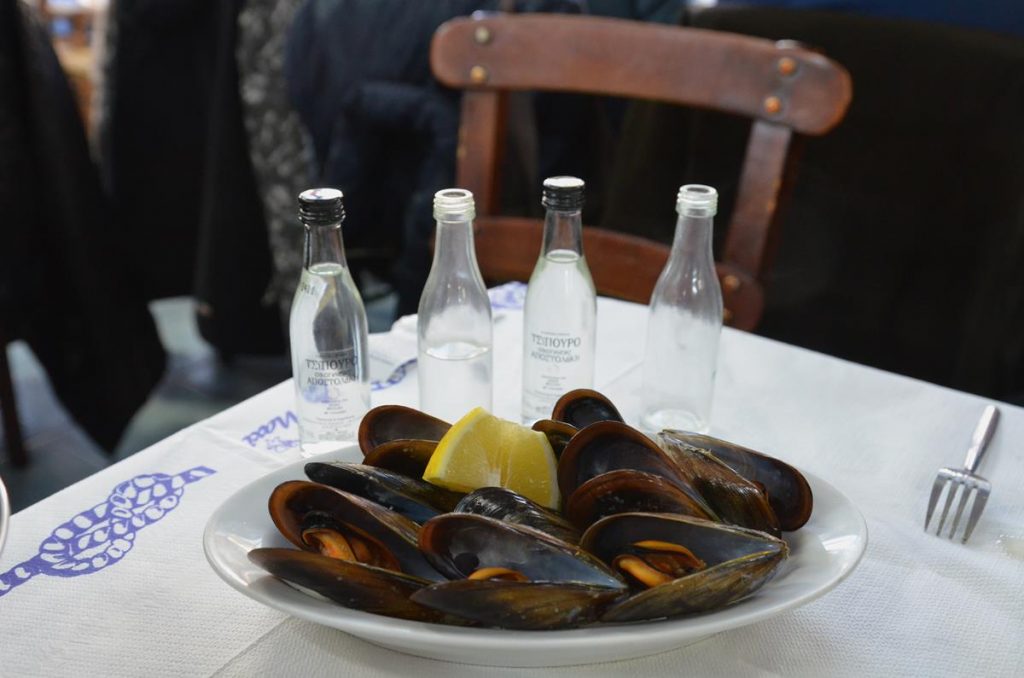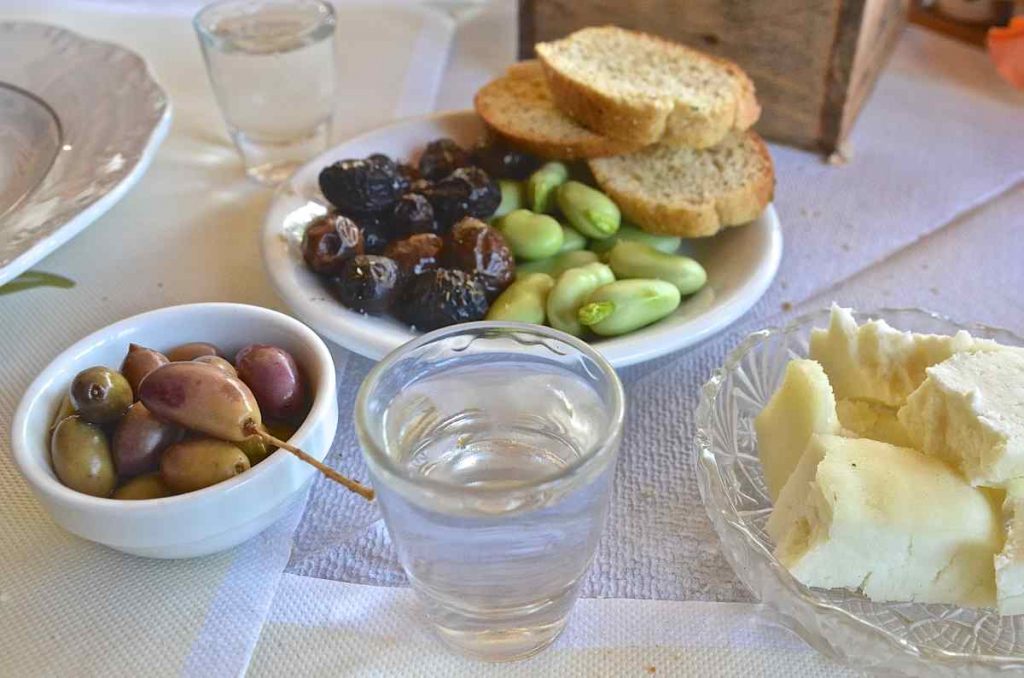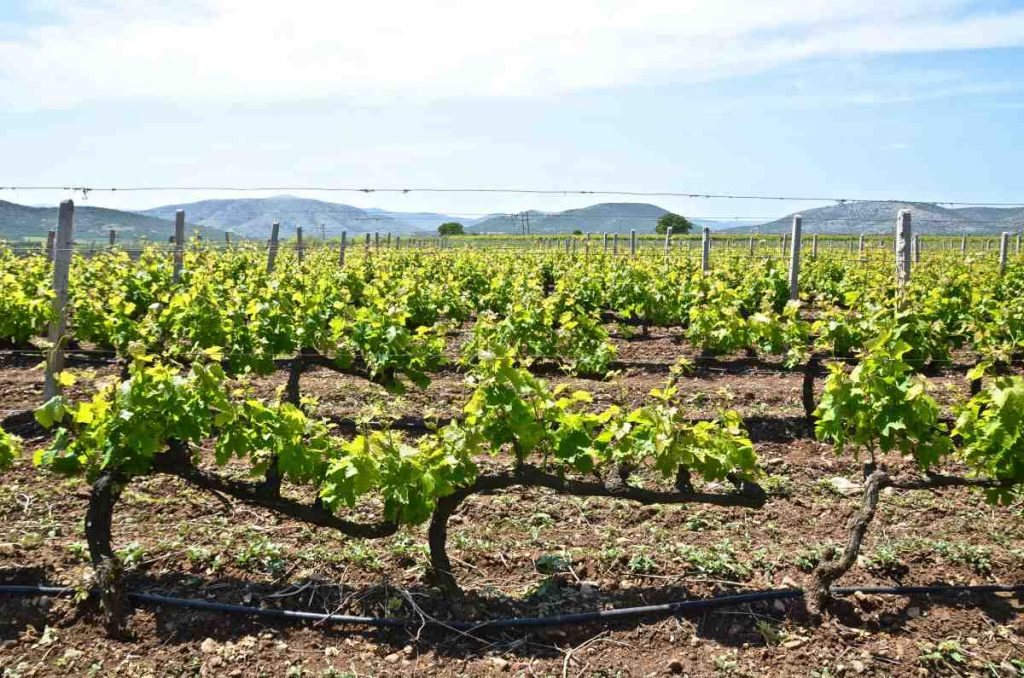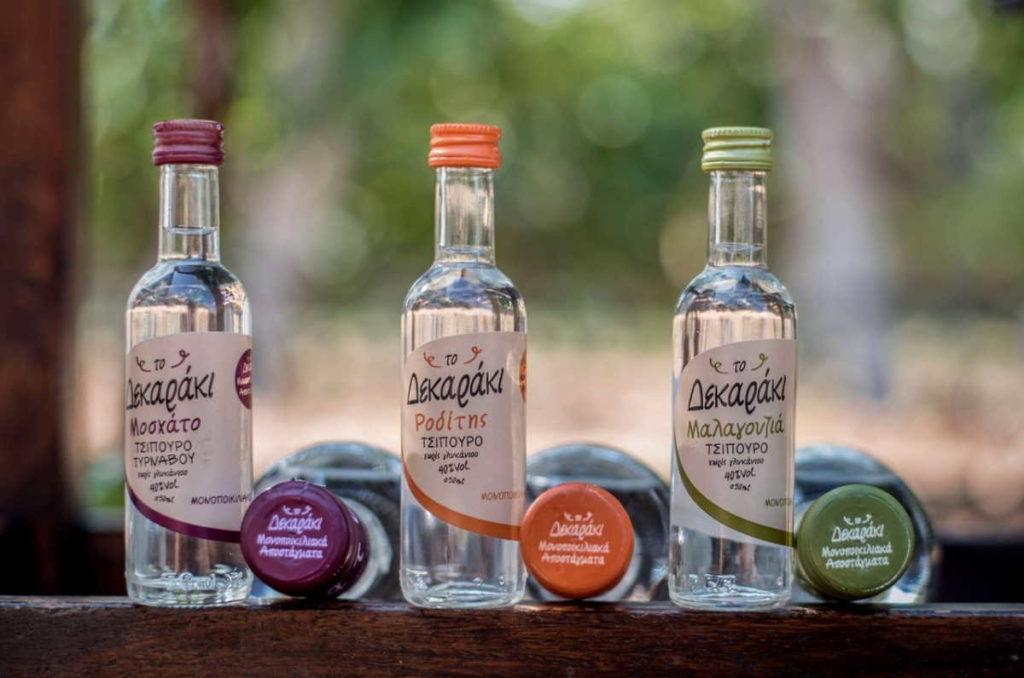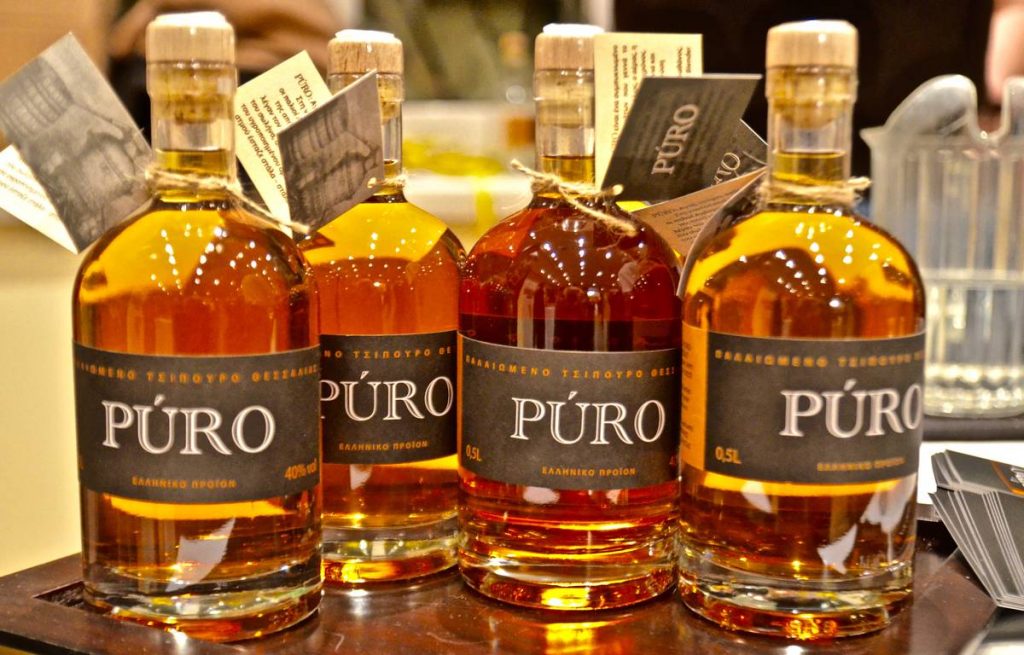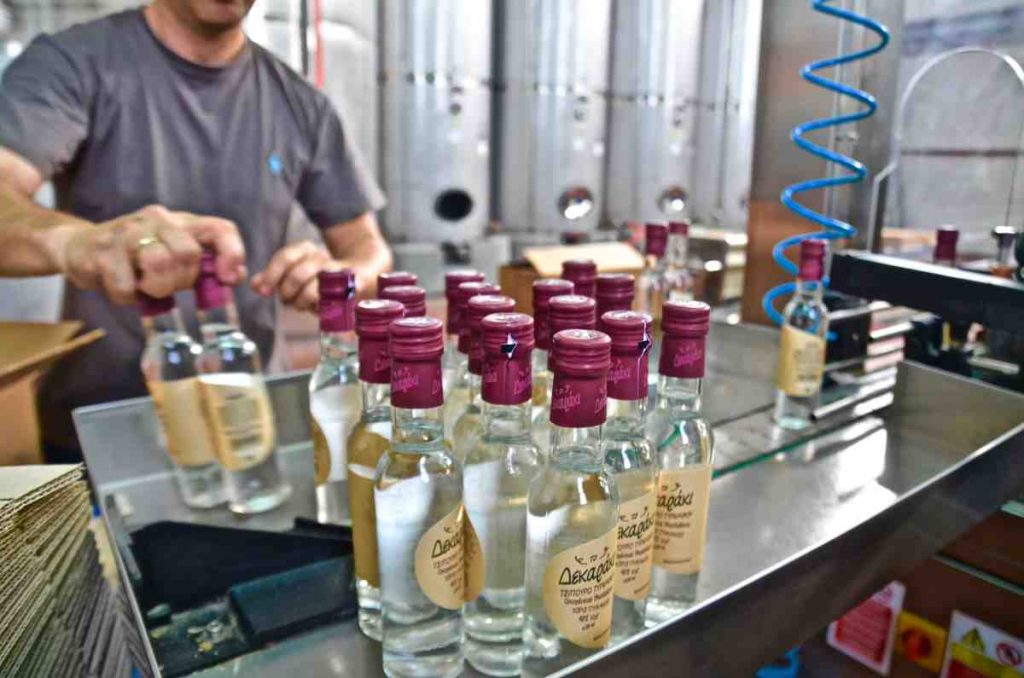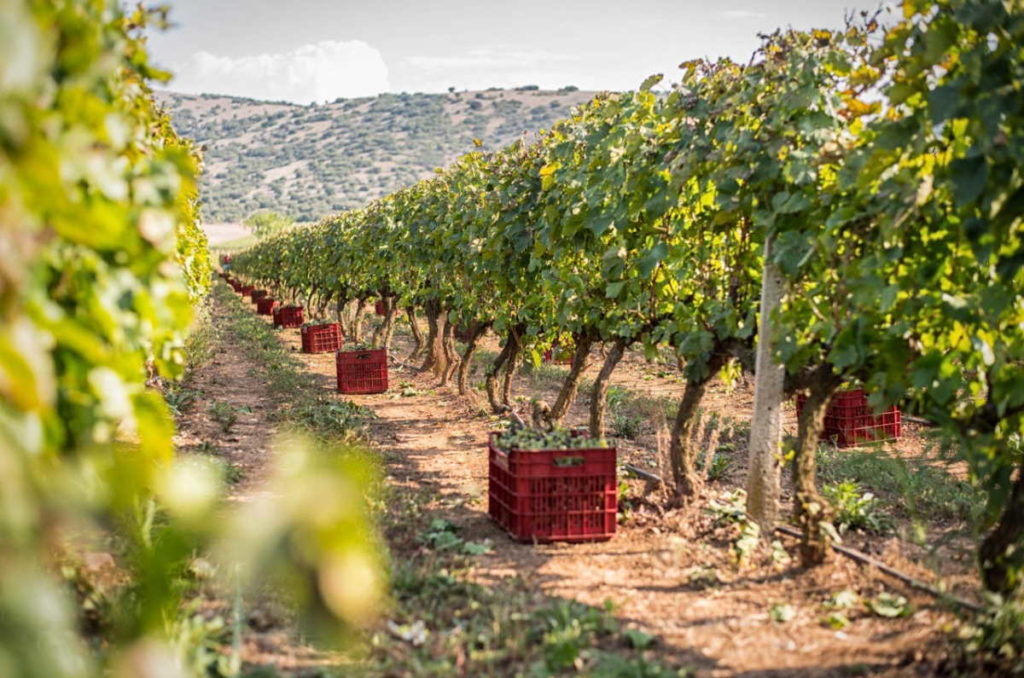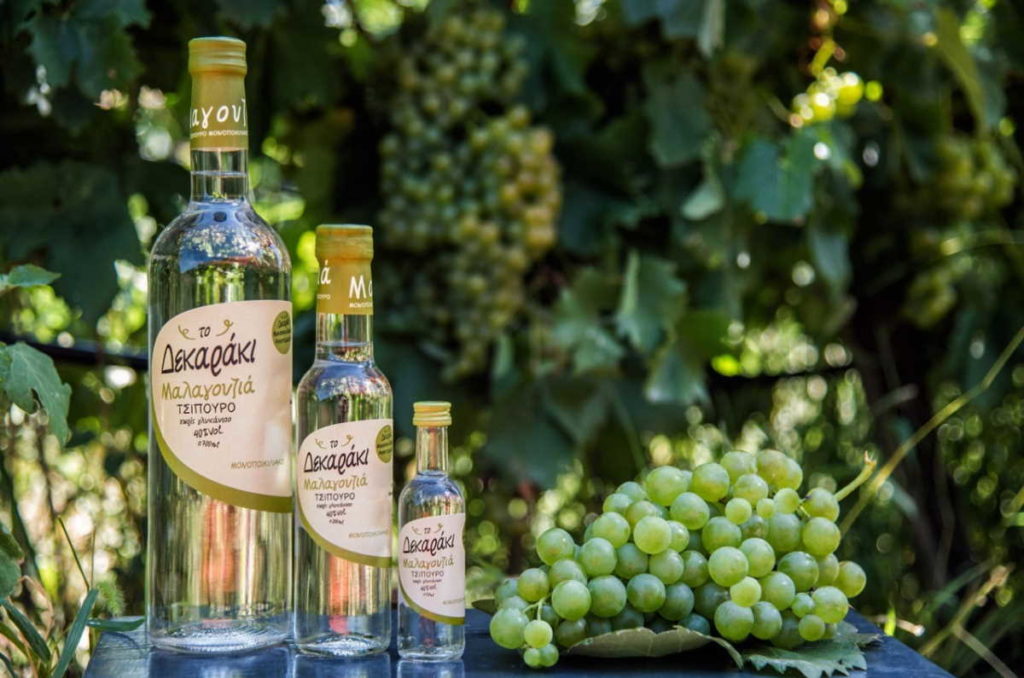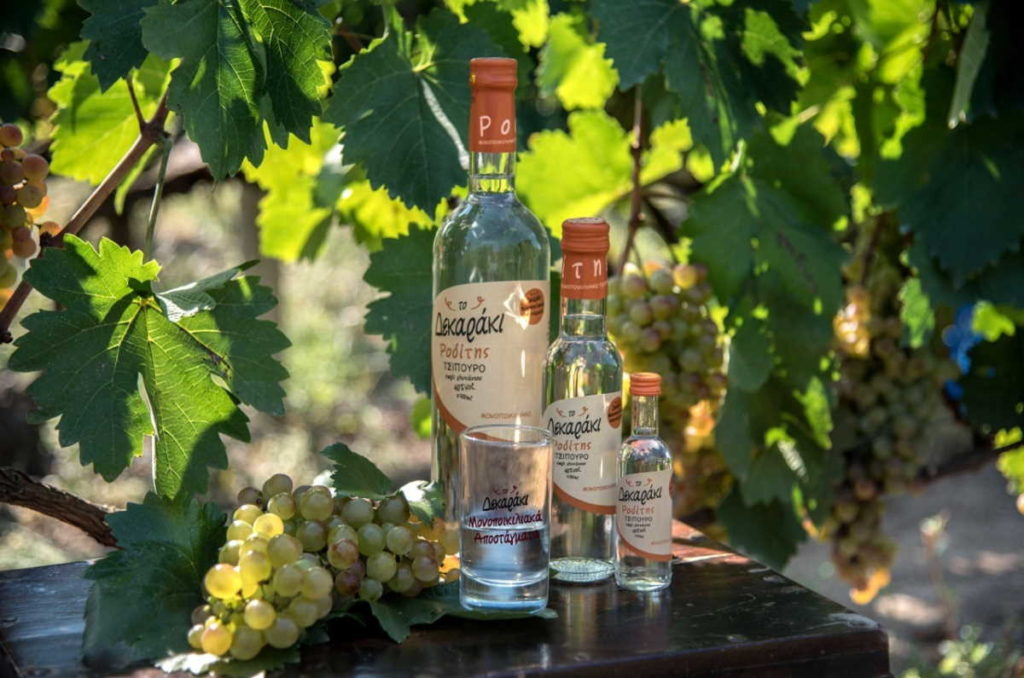From old, the tsipouro, a colorless alcoholic beverage, a product of distillation, is produced and drunk with passion every year throughout the Mediterranean.
Tribute of the Greek Gastronomy Guide to tsipouro:
- Tsipouro in general
- History of tsipouro
- Kazanies, the pre-industrial phase
- The cauldrons today and the battle of bulk tsipouro with the bottled one
- Tsipouro, other spirits and ouzo
- How to produce tsipouro
- Tsipouro as PGI
- Tsipouro philosophy - Tsipouro appetizers - Tsipouro restaurants
- Tsipouro producers
- New trends in tsipouro
- Interview of Ms. Vivi Vasdavanou of the tsipouro "Dekaraki"
Tsipouro in general
It is known by various names: tsipouro, arak, raki, grapa. It is distilled from the by-products of wine, as if man wanted to exploit the vineyard as much as possible.
Tsipouro is called in Greece the distillate of marc. Macedonia, Crete, Thessaly and Epirus have a tradition in the production of tsipouro.
The raw material for the production of distillate is marcs, that is, the mass that remains after the compression of the grape pulp, in order to produce wine.
History of tsipouro
If wine, a product of the magical fermentation of grape juice, is the gift of Dionysus to humanity, Raki and ouzo are the result of the culture of poverty and ingenuity of ordinary people. Thanks to the concern of the people to utilize the remnants of the wine production, but also to the constant effort of the most enlightened of them to deal with alchemy, the process of "dissolution and recomposition", the distillation was created, and from there the discovery of favorite drink of the Greek.
The history of raki (from the Arabic word araq = alcohol), this distillate produced throughout the Mediterranean, is lost in the depths of history, with the first signs of distillation in Crete, in 500 BC. and with a working hypothesis that the abyss, the vessel of distillation, is a Greek invention.
The modern history of raki begins in the era of Ottoman rule, and this is because the Prophet Muhammad did not plan to ban wine and spirits. Starting from Mount Athos, raki conquers the entire Ottoman Empire, with the most important distillation centers being Constantinople, Smyrna, Alexandria, Tyrnavos, Mytilene and Crete.
Kazanies, the pre-industrial phase
If you wander around, in the last days of autumn, in the villages and in the countryside in Macedonia, Crete, Thessaly, Epirus, the Cyclades, you will find tall columns of smoke. The place will "boil" there, because during this period the tsipouro is distilled in the cauldrons.
From a technical point of view, the production of the distillate (suma, tsipouro, raki, tsikoudia) is done with the well-known traditional process. After the August-September harvest, the marcs are put in barrels thanks to the yeasts they contain, to undergo alcoholic fermentation, ie the sugars are converted to ethyl alcohol. Then they go for distillation.
The rakokazano is placed in the hearth and consists of the abyss, which is connected to the lumen, a metal pipe that passes through two tanks of cold water. When the fire is lit, the marcs, water and some herbs are placed in the cauldron. As the boiling begins, the generated vapors fill the ambush and from there are directed to the tube. The vapors, rich in alcohol, come in contact with the cold walls of the tube, liquefy and drip drop by drop at the outlet of the tube, where the raki is collected.
The rakidio during the distillation period is like a beehive, where non-stop XNUMX hours a day there is a constant supply of marcs and wood for the fire, and demigods come and go to receive the liquid fire, appetizers and people, dionysied by the food and drink, the cauldrons are also the occasion for the autumn festivities.
The cauldrons in Crete, in the Cyclades, but also in mainland Greece are among the most shocking events that take place in Greece. Characteristic are boilers of Paros and boilers of Halkidiki.
The cauldrons today and the battle of bulk tsipouro with the bottled
This situation with the cauldrons is maintained today with the institution of "two days". The cauldrons can be owned by a viticulturist or not, who agrees to boil in his cauldron from October 15 to December 15 in addition to his own marcs and other vine growers who have received permission from customs.
So use the carousels (marcs) of their production, securing tsipouro, their favorite drink for the year, an elementary income from the quantity they can sell only in their area, but to celebrate and enjoy the feast of the cauldrons (kazanematon) which is one of the most authentic holidays of the Greek province. The sale in their area and in neighboring prefectures with a special transport license, was valid before 1997. Then with national legislation they can sell all over Greece only with the distillation license (eg if the distillation license says 300 kg of tsipouro can illegally transport 300 kg as many times as they want).
Unfortunately, this institution of amateur distillation - with a legal license of course - has given rights and many windows. Many use vineyard licenses and produce multiple quantities. They also trade imported sea bream, of dubious quality and a great risk for those who consume them, having of course a huge advantage of different taxation. Unfortunately in the old days the private producers of tsipouro drank from the same tsipouro they sold, and the quality was guaranteed. As long as the production of tsipouro was within the framework of the family and the community, the quality was to a certain extent guaranteed, from the moment the commercialization started the thing got out of control and today on the altar of profit the situation has changed.
The battle of bulk with the bottled tsipouro is a great battle and has essentially turned into a battle of the illegal and uncontrollable with the legal, the controllable and in the final analysis of the quality.
It is true that in recent years many wineries and distilleries have invested in multi-distillation facilities and they have achieved very good results with the result that there is a tight front of the professional distillers with the "bulldozers".
And the professional spirits, thanks to their quality, their promotion but also their taste peculiarities, are gaining more and more market share day by day, but the battle is still great.
The problem of uncontrolled distribution of bulk tsipouro, with raw materials of dubious quality, which is taxed at 0,59 euros per liter compared to bottled that is taxed at 5,10 euros per liter but also the lack of control damages the tsipouro itself, whose reputation is undermined by the abusive use of the protected geographical indications "tsipouro" and "tsikoudia" by the two-day huge risk to public health.
Tsipouro, other spirits and ouzo
Up to a point all the distillates were made by primary distillation, they were all from the same mother. At some point ouzo was released and started to be produced in an alcohol solution. It is also comparable to absinthe, the French pastis and is classified in the category of anis, ie alcoholic beverages with anise aroma. In most anises, the aromas are first extracted from the seeds with water and then added to the alcohol solution. In ouzo, traditionally, the aromatic substances are obtained by co-distilling the seeds in a solution of water and alcohol. In taste it resembles tsipouro, a drink that has a different way of preparation.
Today, the name and origin of ouzo are protected by the European Union (Protected Geographical Indication). Which means that it can not be produced anywhere else, except in Greece.
The tsipouro is a distillate that retains the aromatic characteristics of the raw material (grape) as well as the aromas of fermentation.
Η grappa they are productively similar to tsipouro only that the marcs there are not as juicy (with wine) as ours. The pastis produced by co-distillation of alcohol and seeds (anise…) is more like ouzo.
The uve is a distillate of fruit (whole).
How to produce tsipouro
The raw material for the production of distillate (tsipouro) is the marc, ie the mass that remains after the compression of the grape pulp, in order to produce wine. This mass consists of the skins of the grapes, the giants (stones) while it also includes a percentage of unleavened must (must), fermented musts or fully fermented must (wine). In general, giants make up 3-6%, skin 6-9% and flesh 75-85% of this mass. The marcs, in order to give an alcoholic distillate, must on the one hand not have been completely drained and on the other hand have undergone alcoholic fermentation, so that the sugars of the remaining must are converted into alcohol. Tsipouro can be produced from marc that is fermented and comes from red vinification with more or less wine.
The first action for the production of distillate from white unleavened marc is their fermentation. The fermentation takes about 30 days, when the marcs are fermented on their own, and much less when fermented together with the must. During the first distillation we get a distillate (suma) which is 15 to 20% of the original volume. After distillation, the residue is discarded. In the second distillation, fill the abyss (cauldron) by 80-90% with suma. Many times, the product obtained from the first distillation is consumed without undergoing a second distillation. The double distilled tsipouro, however, it is cleaner and finer in aroma and taste.
In the second distillation it is possible to add aromatic raw materials, such as anise, fennel, cloves, nutmeg and mastic. After the second distillation, remove the first 0,5 to 1 liter. It has a high alcohol content and is the "head". Then we collect it "heart" which represents 50% of the original volume. It is the fraction that contains the desired ingredients and which, after being diluted to achieve the desired alcohol levels, will be given to consumption as tsipouro. The rest, the "tail", collect it and place it in the marcs or suma for new distillation. A good alcoholic grade is considered to be 38-45% by volume.
The modern way of making tsipouro from industrial units is done with its method fractional distillation Discontinuous distillation mainly -, where high quality steam boilers are used, fully electronically regulated and controlled. This allows the preparation of a multi-distilled product of high quality, reducing the unwanted substances of the distillation to a minimum and allowing the producer to make the desired separation between heads, hearts and tails.
Tsipouro as a PGI product
The Tyrnavos tsipouro is a registered PGI since 1989 with KAN.1576 / 89 and o Tyrnavos is the only city registered as PGI, with the only commitment that exists is the production and bottling unit to be in the area of Tyrnavos. The other three that are together with Tyrnavos guaranteed by the EU are Macedonia, Thessaly and Tsikoudia of Crete with the same terms.
Tsipouro philosophy - Tsipouro appetizers - Tsipouro restaurants
The tsipouro is served in small glasses and is sometimes consumed plain, but usually accompanied by appetizers. Pastourmas, pastas and olives are considered fine appetizers for tsipouro. In some monasteries of Mount Athos, the monks welcome visitors with tsipouro and a Turkish delight, the combination of which relaxes the muscles and offers energy.
Although tsipouro has always been a "home-made" drink, in recent decades it has become a type of consumer in taverns and other related shops; moreover, the well-known tsipouro restaurants in many - mainly coastal - areas of Greece are famous, offering tsipouro accompanied by a wide variety tsipouro appetizers.
In most such tsipouro restaurants (respectively for ouzo are ouzo) the tsipouro is served in 200 ml caravans, or in 50ml vials, the so-called icospents. A typical popular expression rushed by this is the "Grab a 'kospentar'", which states an order for a 50ml vial. Proportions of the order (number of people, quantity of order) are the appetizers, which appear during the wine drinking with "gastronomic progress". Initially something simple, like a little cheese and olives, and gradually more and more complex flavors, such as saganaki mussels and crab croquettes.
The whole process is a ritual, the purpose of which for the attendant is neither to get drunk nor to be full, but to prolong the social intercourse and the pleasant mood as much as possible. The whole process is more common at noon than in the evening.
The most authentic tsipouro restaurants in Greece are located in Volos. In tsipouro restaurants of Volos you never order. You just announce the number of twenty-five (individual dose of drink) completed with the word "with" or "without" (anise) is meant. The arrival process of the appetizers depends on the number of tsipouro that you will consume. The appetizers of tsipouro (partly ouzo) must have a delicious intensity so as not to be neutralized by the bitterness of the drink. In the beginning come the pickles and the salted ones, continue the fried seafood, and as the consumption progresses, so come the most complex appetizers, which are usually the most expensive.
Tsipouro in humility cafes can be served with poor appetizers such as tomato, cucumber, elitsa always with their dose of vinegar, sardines and salami. Of course, there are also more processed sea breams (double distilled, three-year aging, etc.) that go up in category and require similar fine appetizers, such as roe, smoked salmon and caviar.
At the tsipouro restaurants of Volos the appetizers that you can enjoy are the following:
Savory appetizers, pickles and pastries (olives, peppers, marinated anchovies, sardines, lacquer),
fried appetizers (saganaki, squid, anchovy, atherina, cod, meatballs, aubergines),
various appetizers (dolmadas, eggplant salad, pasturma taramosa salad, spentzofai, cheeses with strong or fatty taste),
seafood delicacies (octopus, shrimp, crayfish, mussels)
and finally the rare (roe, sea urchins, bubbles, oysters, kolitsianos, octopus eggs, fish livers, etc.).
Tsipouro producers
Apart from the traditional distillers that are the "tsipourades" of Tyrnavos, the Katsaros, Kardasis, Vasdavanos, Vryssas, Agrafiotis, Papras, Kavaratzis, Milias and Agricultural Wine Cooperative of Tyrnavos - which was the first Cooperative that produced and bottled tsipouro in Tyrnavos - the most famous producers of tsipouro are Tsantalis, Papatzimopoulos, Lazaridis, Soniadis from Macedonia, the Apostolakis, Tsililis from Thessaly, Glinavos from Epirus etc.
New trends in tsipouro
With or without anise, today's bottled sea breams have won the hearts of young people who drink them in the traditional way and traditional appetizers, but also in the modern way as many bartenders use them as their main ingredient for their cocktails.
There are two modern trends in Greek sea bream today. Sea breams that focus on local grape varieties in their most extreme and special form certified single-variety sea bream and aged sea bream.
In the first category a classic example is the tsipouro of Tyrnavos which is a Geographical Indication recognized and protected by the European Union with the main variety Tyrnavos muscat - due to its rich aromatic character and its intense volatility - to be the "secret" of fame and quality.
It dominates in the category of certified single variety varieties the "Ten" of the distillery of Basdavanos that inaugurated this category.
Common denominator amber shades, rich aromatic palette, with dried notes, nuts and chocolate, the aged sea bream are the new trend and state their identity and presence. Behind them are many years of experimentation, selection of local varieties, combinations of barrel types, games at maturation times - from 12 months to 5 years -, and all this until the distillers decide to put their product to consumption.
The most interesting aged sea bream that can be found in the market are:
Zoinos from Zitsa Winery, Kosteas from Kalamata, Greco Manifesto from Apostolaki Winery, Verino from the Verino distillery, Dark Cave from the Tsilili distillery, Pure from the Karathanos distillery, Kardase from the Kardasi distillery, Wine Distillate Paleothen from Parparousi winery, Cigar Methexis by Costa Lazaridis winery, Tyrnavos from the Tyrnavos Cooperative.
Interview with Vivi Vasdavanou, oenologist of the Vasdavanos Winery-Distillery that produces tsipouro "Dekaraki"
Tsipouro is a drink inextricably linked to the traditional values of Greek life and the hospitable character of its people. It is the drink that relaxes us, makes us communicate with each other around a table. Ms. Vivi BasdavanouOf Winery - Distillery of Vasdavanos that produces the Tsipouro Dekaraki, explains the experience of tsipouro production as well as data related to the industry.
"Tsipouro is an authentic Greek product inextricably linked to the way of life, hospitality and entertainment of the Greeks. Its production begins with the selection of grape varieties, continues with the careful fermentation of their marcs - ie the skins that remain after pressing the grapes and the extraction of the must for the production of wine - and ends with their slow distillation. It is certain that despite the economic crisis, the tsipouro market in Greece is constantly expanding. One reason is the preference of the Greek consumer for authentic, traditional spirits and the second is the choice by more and more consumers of the 100% guaranteed distillate that is sealed in bottles, with the signature and responsibility of each producer.
"Despite its success, however", points out Ms. Basdavanou, "tsipouro has to deal with over-taxation, smuggling and a new Community regulation which provides that spirits with a geographical indication can be bottled outside the specific geographical area from which they come." The oenologist Mrs. Vivi Basdavanou also states that one of the consequences of the over-taxation is the shift to bulk tsipouro, which is mainly trafficked. "Bulk tsipouro on the one hand hides risks to the health of consumers as it is uncontrollable and therefore of dubious quality, on the other hand its preference for bottled deprives jobs and indirectly offers money to a few smugglers who have nothing to do with Greek production. That is why it is important for consumers to prefer branded, bottled spirits ", concludes Ms. Βασδαβάνου.
Dekaraki came to conquer the lovers of tsipouro
"Dekaraki", a single-variety distillate from the exquisite variety Moschato of Tyrnavos, came on the market in 2012 and quickly emerged at the top of the spirits in its category. It stands out for its traditional distillation from the heart of the distillate, highlighting all the authenticity and tradition of the famous "Tsipourou Tyrnavou»- a Geographical Indication recognized by the European Union.
"Dekaraki, a tsipouro balanced with a long aftertaste, has aromas and flavors that refer to fig, raisin, walnut, pear, bergamot, rose and clove," says oenologist Ms. Basdavanou.
"Dekaraki is a quality superior tsipouro - the first single-variety tsipouro in Greece - which we produce with the special technique of using a column with 6 plates that gives us the best and purest piece of tsipouro. It stands out for the quality and aromatic characteristics of Moschato Tyrnavos, for its intense and clean aroma, its rich and warm taste and its crystalline appearance ".
Another element that makes "Dekaraki" so special is the traditional process of distillation, with the know-how and the taste of the Vasdavanos family.
"Multiple redistillation takes place in handmade traditional copper abysses, a slow process that perfects the final product, giving it excellent quality," says Ms. Βασδαβάνου. The result is a pure and authentic distillate, without anise, with an alcoholic degree of 40% vol, whose special identity is highlighted in every sip. That is why it was deservedly named "Dekaraki".
The Ten, with respect and love for tradition and high know-how in the distillation of single-variety tsipouro, presented in 2018 the first family of single-variety spirits, thus giving a new dimension of quality to tsipouro. So next to it Moschato of Tyrnavos, Tsipouro Dekaraki adds and welcomes to the family, two new single-variety spirits, the Malaguzia and Roditi.
Each single-variety tsipouro Dekaraki is distinguished by the special, tasty and aromatic identity given to it by the exquisite grape variety from which it comes. Enjoy high quality spirits and discover their special character!
Muscat the explosive: Strong, warm, rich aromas reminiscent of fig, raisin, walnut, pear, bergamot, rose and clove. Distillate balanced, complex, with a long aftertaste. Dekaraki from Moschato Tyrnavos has a distinct, aromatic character that gives an explosive taste pleasure.
Malagouzia the mansion: Rich, delicate aromas reminiscent of citrus, white flowers such as gardenia, jasmine, honeysuckle as well as notes of honey, lemon, green apple, peach and apricot. Extremely floral distillate, with aromas that enlarge in the mouth and persist in the aftertaste. Dekaraki from Malagouzia highlights the elegant aromas of this exquisite variety.
Roditis the harmonious: Discreet, gentle and clean aromas reminiscent of honey (petimezi), lemon and banana. Dry distillate with a round, full and soft taste. Dekaraki from the excellent variety Roditis (Fox), stands out for the balance in the aromas of tsipouro.



